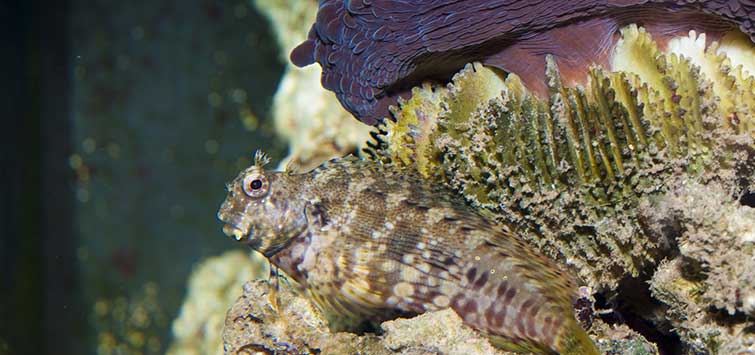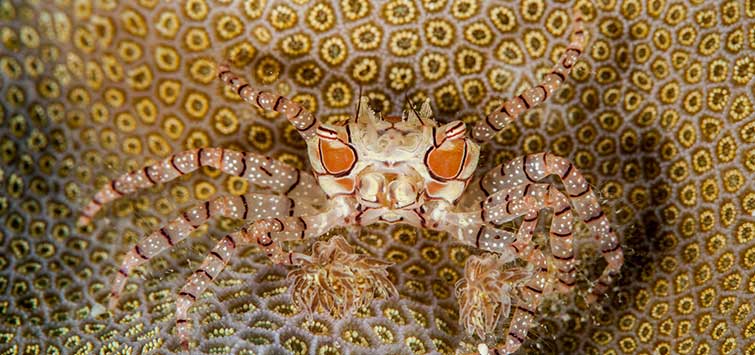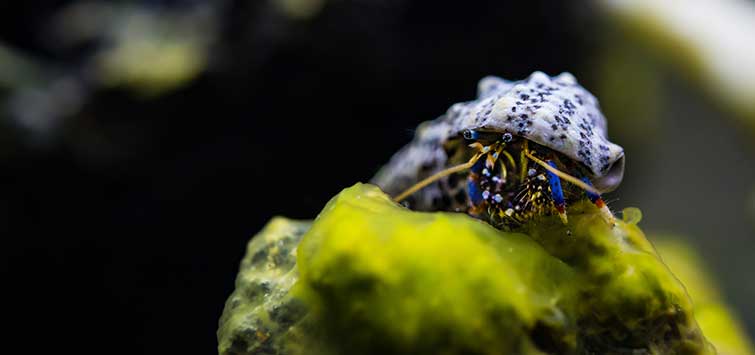Algae-Eating Fishes for the Marine Aquarium
Author: Bob Goemans
Whether you're battling a bit of hair algae on your reef or tackling a full-blown bubble algae infestation, an algae-grazing fish may provide the perfect solution.
When Algae Becomes Overgrown
While difficult to spot when diving, snorkeling, or even watching a coral reef on television, algae of various types are always present and serve as vital components of any natural reef. Algal overgrowth, such as what we see in our tanks, does not occur on a healthy reef because the nutrient-poor waters of a reef are not conducive to rapid algae growth, and what does grow is quickly harvested by the many reef herbivores.
Shallow inland waterways, where nutrient accumulation and agricultural runoff fuel excess algae growth, tend to have the various types of algae problems that many aquarists experience. In fact, the aquarist who has never had to do battle with unwanted algae growth is quite rare!
A decade or two ago, most aquarists considered healthy growths of micro- or macroalgae an indicator of good water quality, an idea that today’s aquarists would probably laugh at. There’s no doubt that excessive growths of unwanted forms of algae have caused some aquarists to leave the hobby in disgust.
Only calcareous algae (such as Halimeda or coralline) or a controlled growth of macroalgae, usually tucked away in a refugium, is considered acceptable. Filamentous, slime-like, bubble, and turf-like growths are almost always considered problematic and are usually both costly and time consuming to remedy.
Dealing with Overgrowth
Aquarists try many different methods—chemical filtration, herbivorous invertebrates, and, of course, herbivorous fishes, as well as other means—to minimize problematic algae that can, if not quickly controlled, smother corals. When it comes to herbivorous fish, there are many different species that will consume particular types of algae.
Surgeonfishes
Probably the most widely used species of herbivorous fish belong to the order Perciformes, suborder Acanthuroidei, and family Acanthuridae—the surgeonfishes. Found in tropical waters around the world, surgeonfishes have disc-shaped, laterally compressed bodies, like those of angelfish and butterflyfish.
Most are algae grazers that are generally found in shallow reef areas and lagoons. Only a few species are recommended for the purpose of grazing on algae, since most species also feed on small crustaceans and detritus. Additionally, once they grow accustomed to being fed regularly with aquarium foods, they fail to actively seek out algae.
Ctenochaetus strigosus
The first tang is Ctenochaetus strigosus, which goes by several common names that include the koli, bristletooth, and yellow-eye tang. It hails from the Indo-Pacific and is usually one of the less-expensive tangs. Its desire to constantly browse on microalgae and small turf-like growths, its peaceful nature, and fairly small size of about 7 inches when fully grown makes it a good choice to help eliminate these unwanted algae growths. If this tang is chosen, stay with only one specimen per tank, as they can get feisty with members of their own species.
C. hawaiiensis
Another great choice in this genus is the chevron tang C. hawaiiensis, though it’s always quite expensive. It hails from the central Pacific and as a juvenile is extremely pretty, having a blue herringbone pattern over an orange-colored body with blue on its fins. Unfortunately, it loses most of this coloration as it grows to maturity and finally turns an olive-brown color. Nevertheless, this somewhat small fish (about 10 inches when fully grown) is a constant browser, feeding on the same types of algae as C. strigosus.
Zebrasoma desjardinii
For removal of more troublesome algae growths, such as filamentous and bubble algae, the sailfin or Red Sea tang Zebrasoma desjardinii can be a good choice. It hails from the Indian Ocean and the Red Sea, and reaching about 16 inches, it is suited to larger aquariums (125 gallons and larger).
Z. veliferum
Another species that browses on these types of algae is the sailfin tang Z. veliferum from the Central and South Pacific. It’s about the same size as Z. desjardinii and is also quite peaceful. To tell the difference between Z. desjardinii and Z. veliferum, there are small circular spots on the snout area of Z. desjardinii. You might be better served if Z. desjardinii is selected, as a fish coming from the Red Sea is just about guaranteed not to have been captured with cyanide.
Zebrasoma flavescens
A fourth tang choice would be the common and usually quite inexpensive yellow tang Zebrasoma flavescens. It will browse on most forms of unwanted algae. These hail from the Indo-West Pacific to Hawai‘i and generally inhabit outer reefs and shallow lagoons where they reach about 8 inches in length. They are well suited for medium to large aquariums, a 75-gallon system or larger.
Rabbitfishes
Related to tangs (sharing both their order and suborder), rabbitfishes belong to the Siganidae family, which consists of one genus with about 25 described species. They mostly hail from the Indo-Pacific and generally inhabit reef areas, with some preferring seagrass beds and mangrove areas.
Though they are omnivorous, rabbitfishes require large amounts of vegetable matter in their diets and are excellent algae grazers. Of the three or four species that commonly make it into the trade, two species are excellent hair algae consumers, making them a real plus in many of today’s aquariums.
Siganus vulpinus
The most common in the trade is the foxface rabbitfish Siganus vulpinus, which can reach a size of 10 inches. Slightly larger and quite similar in appearance (and often misidentified as S. vulpinus), the magnificent rabbitfish S. magnificus is another good algae consumer. Both browse on desirable and unwanted forms of algae as if they were cows in a meadow!
Additional Notes
While most people assume all rabbitfishes are excellent algae eaters, I have found that the blue-spotted rabbitfish S. corallinus does nothing to control algae problems and instead goes for meaty foods and prepackaged greens.
If you do choose a rabbitfish, keep in mind that in late evening hours they will go to a favorite place in the aquarium and lose most of their color, getting quite blotchy in appearance. But when daylight returns, they will regain their coloration and resume browsing on various algae growths. Also, be aware that they have venomous fin spines that can deliver a painful sting to the unwary aquarist—something to keep in mind when handling the fish or performing tank maintenance.
Blennies
Being much smaller fish, members of the family Blenniidae (order Perciformes and suborder Blennioidei) are suited for smaller aquariums. While the blenny family is quite large, having about 50 genera and 350 species, only a few of those species are well suited to consuming algae, usually types of microalgae.
Atrosalarias fuscus
Atrosalarias fuscus, the highfin blenny, is an Indo-Pacific species reaching about 5 inches in length. It usually inhabits coral branches (dead or living) along coastal reefs. It feeds on and will help curb growths of filamentous algae and microalgae. However, I call this species a piggy; it will drive off other herbivorous species to the point where they may be damaged or, at a minimum, greatly stressed. And you need to keep only one specimen per tank, as it has zero tolerance for competition, especially from its own species unless it’s the opposite sex. From the little that is known about this species, only the fish itself can tell if another is of the opposite sex.
As good as the highfin blenny is for controlling unwanted forms of algae, it has a reputation of being a fin nipper and therefore might prove too rowdy in smaller aquariums. Yet in larger aquariums—75 gallons and up—it provides good control over these forms of algae and usually causes less stress to tankmates.
Combtooth Blennies
On the somewhat brighter side, those called combtooth blennies, in the genus Cirripectes, are excellent algae consumers because they have about 100 fine teeth embedded in their lips, not their jaw, which are used to scrape microalgae off rocks and even the sides of the aquarium. Unfortunately, they are rarely seen in the trade and are highly territorial—plus, they’re excellent jumpers! Nevertheless, if you can find a species of combtooth blenny, they make good algae consumers assuming you have the right tank setup.
Salarias fasciatus
Another blenny that has comb-like teeth is the commonly available lawnmower blenny Salarias fasciatus, which hails from the Indo-Pacific, inhabiting algae-covered rocks along coastal waters. It reaches a length of about 5 inches and will consume cyanobacteria/slime algae and other types of microalgae. As with other species, keep one per aquarium; they can get quite feisty with other algae consumers, especially those that are smaller.
Angelfish
There are a few in the family Pomacanthidae (order Perciformes and suborder Percoidei) that can be considered mainly algae consumers. Some angels mostly feed on zooplankton, others feed on sessile invertebrates, and the smaller, dwarf angels of the genus Centropyge tend to feed on algae and detritus. The lemonpeel angelfish C. flavissima is known to be a filamentous and diatom algae consumer. I can personally vouch for the flame angelfish C. loricula being a consumer of Caulerpa in one of my aquariums.
Spotted Scat Scatophagus argus
One of the most overlooked algae-consuming fish is probably the green or spotted scat Scatophagus argus, which belongs to the Scatophagidae (scats) family (order Perciformes and suborder Acanthuroidei) consisting of two genera and four species. They are widespread in the Indo-Pacific and inhabit coastal estuaries and river entrances, including brackish-water areas. The drawback with this species is that it does attain an adult size of 14 inches, which would limit its use to larger aquariums. Most seen in the trade are juveniles and, because of their peaceful coexistence with tankmates, can make ideal browsers of cyanobacteria/slime algae and other algae forms in sufficiently large reef systems.
Final Warnings
A closing warning: Before purchasing any herbivorous species, you need to conduct further research into their individual needs and compatibility requirements—for example, some species see invertebrates as tasty snacks. And before purchasing any animal for the purpose of limiting/controlling unwanted algae, you should find out the reason why those growths exist in the first place. Without correcting the root problem of those unwanted growths, the chances of resolving them with herbivorous animals are usually quite slim.
Furthermore, as with any selection of fishes, if the aquarium is fed large quantities of commercially prepared foods, many fish become used to an easy lifestyle where they don’t have to work for their meals. They then become less apt to browse the aquarium and spend more of their time waiting for another free meal.
See the full article on TFH Digital http://www.tfhdigital.com/tfh/201006/#pg93

.png?h=595&iar=0&w=2781&hash=5FD5E69473BCC22199FBFA2FB71B6033)



